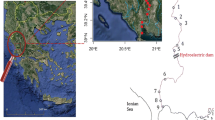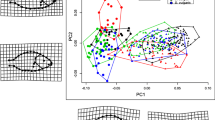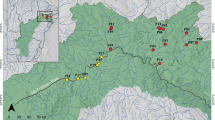Abstract
The morphology of fishes plays a very important role in the ecosystem biodiversity to show different evolutionary strategies. The morphological variations among species can be graphically represented in a morphospace and analysed using different methods. In this study we used different assemblages of mesopelagic fishes living in the Canary Islands (North-eastern Atlantic) to compare two methods: convex hull and patterning. The results demonstrated that the patterning of morphospace allowed understanding better the specific ecological strategies and structure of fish assemblages. By contrast, the convex hull is focused on a reduced number of species with a high level of morphological diversity which is located in the periphery of the morphospace. The study demonstrates that patterning analysis is a better tool for comparing these assemblages than convex hull, and it highlights the relevance of the distribution of points within the morphospace for characterizing fish assemblages.





Similar content being viewed by others
References
Barlow KA, Sutton T (2008) Ecology of the midwater fish family Melamphaidae over the Mid-Atlantic Ridge. ICES CM 2008/C 17:1–10
Bookstein FL (1991) Morphometric tools for landmark data: geometry and biology. Cambridge University Press, New York
Bordes F, Wienerroither R, Uiblein F, Moreno T, Bordes I, Hernàndez V, Caballero C (2009) Catálogo con las especies meso y batipelágicas. Peces, moluscos y crustáceos. Colectadas con arrastre en las islas Canarias durante las campañas a bordo del B/E “La Bocaina”. ICCM-ASCII-Gobierno de Canarias. Las Palmas, Spain
Cartes JE, Hidalgo M, Papiol V, Massuti E, Moranta J (2009) Changes in the diet and feeding of the hake Merluccius merluccius at the shelf-break of the Balearic Islands: influence of the mesopelagic-boundary community. Deep-Sea Res I 56:344–365
Clarke KR, Gorley RN (2006) PRIMER v6: user manual/ tutorial. PRIMER-E, Plymouth, UK
Colgate JE, Lynch KM (2004) Mechanics and control of swimming: a review. IEEE J Ocean Engin 29:660–673
Collin SP, Partridge JC (2006) Retinal specializations in the eyes of deep-sea teleost. J Fish Biol 49:157–174
Davis MP, Chakrabarty P (2011) Tripodfish (Aulopiformes: Bathypterois) locomotion and landing behaviour from video observation at bathypelagic depths in the Campos Basin of Brazil. Mar Biol Res 7:297–303
De Witt FA, Cailliet GM (1972) Feeding habits of two bristlemouth fishes, Cyclothone acclidens and C. signata (Gonostomatidae). Copeia 3:868–871
Drew JA, Buxman CL, Holmes DD, Mandecki JL, Mungkaje AJ, Richardson AC, Westneat MW (2012) Biodiversity inventories and conservation of the marine fishes of Bootless Bay, Papua New Guinea. BMC Ecol 12:15
Farré M, Tuset VM, Maynou F, Recasens L, Lombarte A (2013) Geometric morphology as an alternative for measuring the diversity of fish assemblages. Ecol Indic 29:159–166
Foote M (1997) The evolution of morphological diversity. Annu Rev Ecol Evol Syst 28:129–152
Gartner JV, Crabtree RE, Sulak KJ (1997) Feeding at depth. In: Randal DJ, Farrel AP (eds) Deep-sea fishes. Academic Press, New York, pp 115–93
Goatley CHR, Bellwood DR, Bellwood O (2010) Fishes on coral reefs: changing roles over the past 240 million years. Paleobiol 36:415–427
Gotelli NJ, Colwell RK (2001) Quantifying biodiversity: procedures and pitfalls in the measurement and comparison of species richness. Ecol Lett 4:379–391
Gosline WA (1994) Function and structure in the paired fins of scorpaeniform fishes. Environ Biol Fish 40:219–226
Haddock SHD, Moline MA, Case JF (2010) Bioluminescence in the Sea. Annu Rev Mar Sci 2:443–493
Hammer Ø, Harper DAT (2006) Paleontological data analysis. Blackwell Publishing, Oxford
Hopkins TL, Sutton TT, Lancarft TM (1996) The trophic structure and predation impact of a low latitude midwater fish assemblage. Prog Oceanogr 38:205–239
Kassam DD, Adams DC, Ambali AJD, Yamaoka K (2003) Body shape variation in relation to resource partitioning within cichlid trophic guilds coexisting along the rocky shore of Lake Malawi. Anim Biol 53:59–70
Kneitel JM, Chase JM (2004) Trade-offs in community ecology: linking spatial scales and species coexistence. Ecol Lett 7:69–80
Lavin PA, Mcphail JD (1985) The evolution of freshwater diversity in threespine stickleback (Gasterosteus aculeatus): site-specific differentiation of trophic morphology. Can J Zool 63:2632–2638
Layman CA, Langerhans RB, Winemiller KO (2005) Body size, not other morphological traits, characterizes cascading effects in fish assemblage composition following commercial netting. Can J Fish Aquat Sci 62:2802–2810
Lombarte A, Aguirre H (1997) Quantitative differences in the chemoreceptor systems in the barbels of two species of Mullidae (Mullus surmuletus and M. barbatus) with different bottom habitats. Mar Biol Prog Ser 150:57–64
Lombarte A, Gordoa A, Whitfield AK, James NC, Tuset VM (2012) Ecomorphological analysis as a complementary tool to detect changes in fish communities following major perturbations in two South African estuarine systems. Environ Biol Fish 94:601–614
McClain CR, Johnson NA, Rex MA (2004) Morphological disparity as a biodiversity metric in lower bathyal and abyssal gastropod assemblages. Evol 58:338–348
Mauchile J, Gordon JDM (1986) Foraging strategies of deep-sea fish. Mar Ecol Prog Ser 27:227–238
Muss BJ, Nielsen JG (1999) Sea fish. Scandinavian Fishing Year Book. Hedehusene, Denmark
Olivar MP, Bernal A, Molí B, Peña M, Balbín R, Castellón A, Miquel J, Massutí E (2012) Vertical distribution, diversity and assemblages of mesopelagic fishes in the western Mediterranean. Deep-Sea Res I 62:53–69
Pierce SE, Angielczyk KD, Rayfield EJ (2009) Morphospace occupation in thalattosuchian crocodylomorphs: skull shape variation, species delineation and temporal patterns. Paleontol 52:1057–1097
Pusch C, Beckmann A, Porteiro FM, Westernhagen von H (2004) The influence of seamounts on mesopelagic fish communities. Arch Fish Mar Res 51:165–186
Recasens L, Lombarte A, Sánchez P (2006) Teleostean fish composition and structure of an artificial reef and a natural rocky area in Catalonia (North Western Mediterranean). Bull Mar Sci 78:71–82
Ricklefs RE (1990) Ecology, 3rd edition. W.H. Freeman, New York
Ricklefs RE (2012) Species richness and morphological diversity of passerine birds. Proc Natl Acad Sci 109:14482–14487
Rohlf FJ (2001) TPS Dig 1.31 and TPS relative wards software. State University of New York at Stony Brook, New York
Rohlf FJ, Marcus LF (2003) A revolution in morphometrics. Trends Ecol Evol 8:129–132
Ross SW, Quattrini AM, Roa-Varón AY, McClain JP (2010) Species composition and distributions of mesopelagic fishes over the slope of the north-central Gulf of Mexico. Deep-Sea Res II 57:1926–1956
Roy K, Foote M (1997) Morphological approaches to measuring biodiversity. Trends Ecol Evol 12:277–281
Salvanes AGV, Kristoffersen JB (2001) Mesopelagic Fishes. In: Steel J, Thorpe S, Turekian K (eds) Encyclopedia of Ocean Sciences. Academic Press, San Diego. pp 1711-1717
Shen B, Dong L, Xiao S, Kowalewski M (2008) The Avalon explosion: evolution of Ediacara morphospace. Science 319:81–84
Shimazaki M, Nakaya K (2004) Functional anatomy of the luring apparatus of the deep-sea ceratioid anglerfish Cryptopsaras couesii (Lophiiformes: Ceratiidae). Ichthyol Res 51:33–37
Sutton TT, Hopkins TL (1996) The species composition, abundance and vertical distribution of the stomiid (Pisces: Stomiiformes) fish assemblage of the Gulf of Mexico. Bull Mar Sci 59:530–542
Tyszka J (2006) Morphospace of foraminiferal shells: results from the moving reference model. Lethaia 39:1–12
Uiblein F, Bordes F (1999) Complex trophic interactions around ocean islands. Ocean Challenge 9:15–16
Villéger S, Novack-Gottshall PM, Mouillot D (2011) The multidimensionality of the niche reveals functional diversity changes in benthic marine biotas across geological time. Ecol Lett 14:561–568
Walker JA (2010) An integrative model of evolutionary covariance: a symposium on body shape in fishes. Integr Comp Biol 50:1051–1056
Ward AB, Mehta RS (2010) Axial elongation if fishes: using morphological approaches to elucidate developmental mechanisms in studying body shape. Integr Comp Biol 50:1091–1105
Werdelin L, Lewis ME (2013) Temporal change in functional richness and evenness in the Eastern African Plio-Pleistocene carnivoran guild. PLoSONE 8: e57944
Wienerroither R, Uiblein F, Bordes F, Moreno T (2009) Composition, distribution, and diversity of pelagic fishes around the Canary Islands, Eastern Central Atlantic. Mar Biol 5:328–344
Yamanoue Y, Setiamarga DHE, Matsuura K (2010) Pelvic fins in teleosts: structure, function and evolution. J Fish Biol 77: 1173–1208
Acknowledgments
The surveys were carried out in projects supported by the Viceconsejería de Pesca del Gobierno de Canarias. We especially thank Mrs. Isabel Bordes Cabrera for the fish drawings in this paper by allowing its reproduction from the book “Catálogo de especies meso y batipelágicas. Peces, moluscos y crustáceos. Colectadas con arrastre en las Islas Canarias durante las campañas realizadasa bordo del B/E “La Bocaina”. ICCM-Gobierno de Canarias. This research has been partially sponsored by the Spanish projects CTM2008-04489-C03-03 and CTM2012-39587-C04-03. Marc Farré Foix acknowledges a pre-doctoral grant from the Government of Andorra, ATC010-AND, academic year: 2012–2013.
Author information
Authors and Affiliations
Corresponding author
Electronic supplementary material
Below is the link to the electronic supplementary material.
About this article
Cite this article
Tuset, V.M., Farré, M., Lombarte, A. et al. A comparative study of morphospace occupation of mesopelagic fish assemblages from the Canary Islands (North-eastern Atlantic). Ichthyol Res 61, 152–158 (2014). https://doi.org/10.1007/s10228-014-0390-2
Received:
Revised:
Accepted:
Published:
Issue Date:
DOI: https://doi.org/10.1007/s10228-014-0390-2




